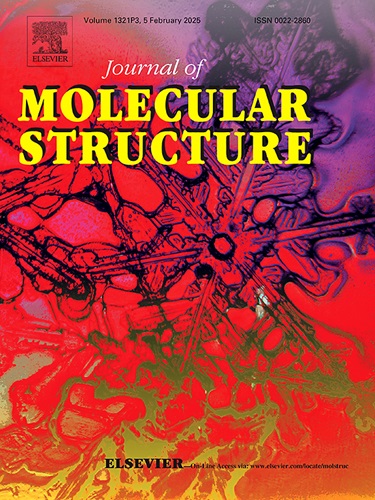食用染色快绿FCF与消化酶胰蛋白酶相互作用的评价
IF 4
2区 化学
Q2 CHEMISTRY, PHYSICAL
引用次数: 0
摘要
快速绿色荧光增白剂(FCF)可用于染料、化妆品、药品和食品。由于染料对人体大分子有不良影响,因此需要对这些影响进行调查,以获得有关这些染料有害影响的明确信息。胰蛋白酶是主要的消化酶之一。研究这两种对人体健康至关重要的物质之间的相互作用。利用电子吸收和荧光光谱技术(淬火类型、结合常数、结合位置数、热力学参数、同步荧光、FRET 分析、二维和三维荧光分析、共存药物和金属离子的影响)、傅立叶变换红外光谱技术、热稳定性、动力学和分子对接技术,研究了 FCF 对胰蛋白酶结构和活性的影响。荧光淬灭和电子吸收结果表明,淬灭过程是一种静态模式。成键过程的主要驱动力是氢键和范德华力,焓和熵的变化均为负值。同步、二维和三维荧光分析表明,FCF 与胰蛋白酶的结合会导致酶的一些微环境和构象变化。热稳定性研究表明,FCF 与胰蛋白酶的相互作用可提高酶的 Tm 点和稳定性。此外,动力学研究表明,FCF 在混合抑制模型中抑制了胰蛋白酶的活性。分子对接研究验证了上述实验结果。分子对接模拟评估了 FCF 与胰蛋白酶氨基酸残基之间的相互作用。研究结果表明,胰蛋白酶活性位点内的结合亲和力得分很强,这与荧光淬灭、热力学分析和可溶解表面积(SASA)计算结果一致。这种一致性表明,对接可以有效地验证实验观察结果,为了解支配 FCF 结合的分子相互作用及其对酶活性的潜在影响提供补充见解。本文章由计算机程序翻译,如有差异,请以英文原文为准。
Evaluation of the interaction of food dye fast green FCF with the digestive enzyme trypsin
Fast green FCF (FCF) is used for dyes, cosmetics, drugs, and food. Due to the adverse effects of dyes on human macromolecules, these effects need to be investigated to obtain clear information on the harmful effects of these dyes. Trypsin is one of the main digestive enzymes. Researching the interaction between the two essentials for human health. The effects of the FCF on the structure and activity of the trypsin were carried out using electronic absorption and fluorescence spectroscopy (type of quenching, binding constant, number of binding locations, thermodynamic parameters, synchronous fluorescence, FRET analysis, 2D, and 3D fluorescence analysis, effect of coexistent drugs and metal ions), FTIR, thermal stability, kinetic and molecular docking techniques. Fluorescence quenching and electronic absorption results showed that the quenching process was a static mode. The bonding process's main driving force was hydrogen bonding and van der Waals forces with negative enthalpy and entropy changes. Synchronous, 2D and 3D fluorescence analyses suggested that the binding of the FCF to trypsin leads to some microenvironmental and conformational changes in the enzyme. The thermal stability study indicated that the FCF and the trypsin interaction could lead to a higher Tm point and stability for the enzyme. Additionally, kinetic studies showed that the FCF inhibited the trypsin activity in a mixed inhibition model. Molecular docking studies validated the above experimental results. Molecular docking simulations were conducted to assess the interactions between the FCF and the amino acid residues of trypsin. The findings demonstrate strong binding affinity scores within the active site of trypsin, which agree with fluorescence quenching, thermodynamic analyses, and solvent-accessible surface area (SASA) calculations. This consistency suggests that docking can effectively validate experimental observations, providing complementary insights into the molecular interactions governing the FCF binding and its potential impact on enzyme activity.
求助全文
通过发布文献求助,成功后即可免费获取论文全文。
去求助
来源期刊

Journal of Molecular Structure
化学-物理化学
CiteScore
7.10
自引率
15.80%
发文量
2384
审稿时长
45 days
期刊介绍:
The Journal of Molecular Structure is dedicated to the publication of full-length articles and review papers, providing important new structural information on all types of chemical species including:
• Stable and unstable molecules in all types of environments (vapour, molecular beam, liquid, solution, liquid crystal, solid state, matrix-isolated, surface-absorbed etc.)
• Chemical intermediates
• Molecules in excited states
• Biological molecules
• Polymers.
The methods used may include any combination of spectroscopic and non-spectroscopic techniques, for example:
• Infrared spectroscopy (mid, far, near)
• Raman spectroscopy and non-linear Raman methods (CARS, etc.)
• Electronic absorption spectroscopy
• Optical rotatory dispersion and circular dichroism
• Fluorescence and phosphorescence techniques
• Electron spectroscopies (PES, XPS), EXAFS, etc.
• Microwave spectroscopy
• Electron diffraction
• NMR and ESR spectroscopies
• Mössbauer spectroscopy
• X-ray crystallography
• Charge Density Analyses
• Computational Studies (supplementing experimental methods)
We encourage publications combining theoretical and experimental approaches. The structural insights gained by the studies should be correlated with the properties, activity and/ or reactivity of the molecule under investigation and the relevance of this molecule and its implications should be discussed.
 求助内容:
求助内容: 应助结果提醒方式:
应助结果提醒方式:


